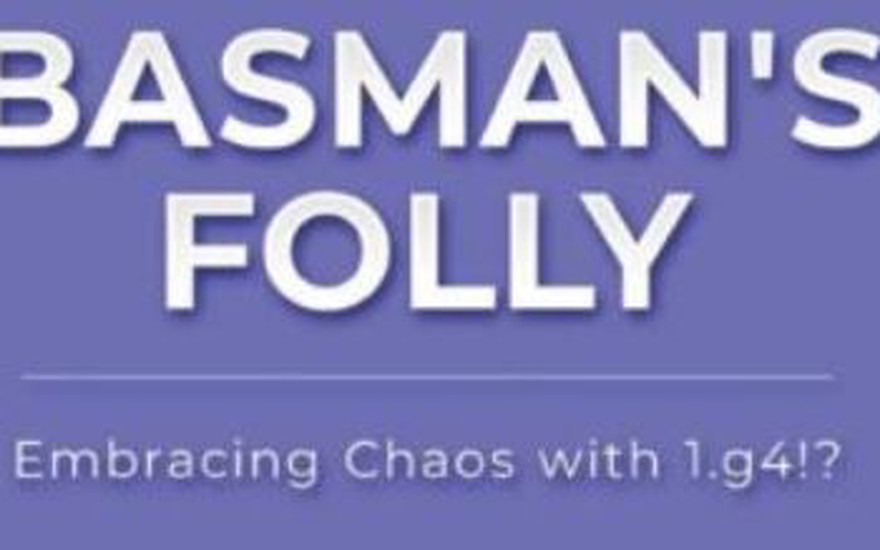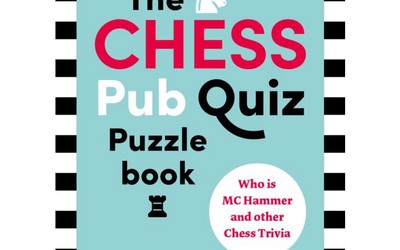
Review: Basman's Folly (1 g4) by Lakdawala and Hansen
Review by FM James Vigus of Lakdawala & Hansen's book on the GrobBasman's Folly: Embracing Chaos with 1 g4
By Cyrus Lakdawala and Carsten Hansen
CarstenChess - Opening Hacker Files
Paperback, 320 pages
Embracing Chaos
The extraordinarily productive duo, IM Lakdawala and FM Hansen, have produced a surprisingly large book on 1 g4 in the self-published Opening Hacker Files series. This is a brave topic to choose in the silicon era. 1 g4 is White's most weakening first move. It makes Stockfish's evaluation plunge. Basman's Folly is an exception in this series in that the authors are not seriously recommending reliance on this opening. Yes, Carlsen and Nakamura dabble in it in blitz games, but objectively the best the authors can say of 1 g4 is 'we can't honestly say it's refuted' (p. 16).
1 g4 has always had shock value. A report on a blindfold exhibition by Johannes Zukertort in 1883 concluded:
When Mr Lovenhart opened 1 P-KKt4 the doctor waited a full minute before he made his reply. A bystander suggested that Zukertort was not thinking of the game but merely trying to form a mental image of the man who would open a game in that manner. (Edward Winter's Chess Notes 7112)
As a surprise weapon, 1 g4 does have certain advantages:
- it can provoke an over-reaction;
- hardly anyone is prepared for it;
- it tends to lead to unusual, even irrational positions.
The book's subtitle, 'Embracing Chaos', puts it perfectly.
What is in this book
Contents:
3 Foreword by IM Gerard Welling
14 Introduction
24 Chapter 1: Basman's Scandinavian and Advanced French Defense
66 Chapter 2: Catalan Gambit Versions
91 Chapter 3: Early c2-c4 Variants
139 Chapter 4: Setups Involving d2-d3
167 Chapter 5: The Other Wing Gambit
177 Chapter 6: Grob/Basman Versus Sicilian
187 Chapter 7: Symmetrical English Style
195 Chapter 8: Reversed Benoni Setups
209 Chapter 9: Miscellaneous Setups
256 Chapter 10: Playing the Grob/Basman a Move Down!
312 Index of main games
314 Acknowledgments
The material consists of 51 annotated games. The majority of these feature the late IM Mike Basman on the White side. The final chapter features 1...g5 (or 1...h6, 2...g5) setups for Black, triumphantly concluding with Basman's remarkable demolition of Speelman in 1980:
The majority of the games begin 1 g4 d5, after which both the dubious gambit 2 Bg2 and the Basman-approved 2 h3 are covered extensively.
There is an index of games, but no index of variations. This, together with the relatively loose thematic arrangement of the chapters, can make it tricky to locate particular lines. This is potentially frustrating for the reader. However, it is understandable since tracking transpositions is a thankless task in such an anti-theoretical opening.
On a minor point, I'm not sure that naming branches of 1 g4 by analogy with other openings works very well. For example, the positions in chapter 1, mostly beginning 1...d5 2 h3 e5 3 Bg2 c6 4 d4, don't really resemble either the French or the Scandinavian much.
Is Basman's Folly worth reading?
I think it is. The great strength of this book is its close examination of some of Basman's most creative achievements. Although 'only' an IM, Basman combined tactical sharpness with some deep and original positional concepts. This is emphasized in Gerard Welling's Foreword. (For my tribute to Basman, see this blog post.) The annotations are generally good, covering the whole game and sometimes providing the reader with tactical puzzles. Playing through these games is an entertaining and mind-expanding experience even if, like me, you don't plan to experiment with 1 g4 other than in online blitz. The reader must be prepared for Lakdawala's famously flamboyant prose.
Nomenclature and history
I like the new name 'Basman's Folly' for 1 g4, though Basman himself endorsed Henri Grob's claim to paternity, and Lakdawala and Hansen sometimes go with 'Grob/Basman'. For more on Grob's use of 1 g4, this article by Andrew Martin is interesting.
Looking closer
I found this book very interesting, but in some ways it could have been improved.
First, there are certain omissions. Some of these were avoidable by checking repertoire works for Black that cover 1 g4. (Since there is no bibliography it is hard to know exactly what was on the authors' radar.) In particular:
After 1 g4 d5 2 Bg2?! Black can safely take the pawn: 2...Bxg4 3 c4 c6 and now if 4 cxd5 cxd5 5 Qb3 Black needs to avoid the trap 5...e6?? losing the bishop. Curiously, that seems not to be mentioned in the book, which focuses on 4 Qb3. Now, as Lakdawala and Hansen rightly note, 4...e6 5 Qxb7 Nd7 favours Black. Alternatively, Christoph Sielecki in Keep it Simple for Black (2022) gives 4...Nf6 5 Qxb7 Nbd7: 'White has a severe lack of development and has weakened their kingside'.
Lakdawala and Hansen omit the Romford Countergambit, 1 g4 d5 2 Bg2 Bxg4 3 c4 d4!? 4 Bxb7 Nd7 5 Bxa8 Qxa8. In Unorthodox Openings (1987) Benjamin and Schiller speculated that this was the reason Basman preferred 2 h3, though Basman is said to have denied this with the words: 'who's afraid of the Romford Countergambit?'
In Beating Unusual Chess Openings (2006), Richard Palliser analysed the Grob in depth, providing several solutions for Black, including the modification 3...dxc4!? in the line just given. Again this is interesting, but unmentioned by Lakdawala and Hansen.
Another fairly critical line is 1 g4 d5 2 h3 e5 3 Bg2 Nc6 3 Bg2 Nc6 4 c4 dxc4 - another of Palliser's lines. Now the authors examine 5 Bxc6+ (Basman-Summerscale, London 1989), but omit 5 Qa4, though Basman recommended this in his book The Killer Grob (1991).
All that said, arguably theoretical omissions are less significant with an opening like this than with standard openings.
However, secondly, the book needed some further editing and proofreading. For example:
p. 33: Basman's opponent in game 4 was not 'A.R. Barton' but R.A. Barton.
This game began 1 g4 e5 2 Bg2 d5 3 h3 c6 4 d4 d4 4 c4 Bd6 6 Nc3 Ne7, a position Basman's games reached relatively often. Instead of 7 g5, we're told that 'Basman in his "Macho Grob" audio tape, suggested 7 Bg5!? f6 8 Bd2 0-0 9 Qb3 Kh8 10 cxd5 cxd5 11 Nxd5 Bc6 12 Bxe4 Ne7...', and the line continues for several moves. Unfortunately that last move is impossible.
Also, it was worth mentioning that this line was played in Basman-Kudrin, Manchester 1981, which deviated with 10 Rc1 (Basman lost horribly). Basman's exploits in that Manchester tournament can be conveniently viewed on John Saunders's Britbase site.
p. 86: the note to Black's 11th reads: 'Taulbut didn't continue to refuse the gift', but the opposite is meant.
p. 117, note to 1 g4: 'Of course, the fact that Aaron Summerscale later became a grandmaster doesn't deter Michael, in the least, from his beloved opening'. I'm not sure what to make of this: to be intimidated by an opponent's future achievements must be either pusillanimous or clairvoyant.
p. 157, the game Basman-Wall, Richmond rapidplay 1999 began 1 g4 d5 2 h3 c6 3 Bg2 h5, when the note says: 'Black immediately wins his White's advanced g-pawn'. I'm unsure what was meant.
Conclusion
Although I have pointed out some blemishes and oddities, this book provides an entertaining and often enlightening initiation into Basman's practically unique style of chess. It goes without saying, too, that it's an essential acquisition for any reader seriously tempted to try 1 g4.
More blog posts by Minckwitz

Review: The Perfect Pirc-Modern by Viktor Moskalenko
This is a review by FM James Vigus of Moskalenko's The Perfect Pirc-Modern
Review: Some instructional and training works
Review by FM James Vigus of recent training/calculation books
Review: The Hungarian Dragon by Junior Tay
A review by FM James Vigus of Junior Tay's 'The Hungarian Dragon'